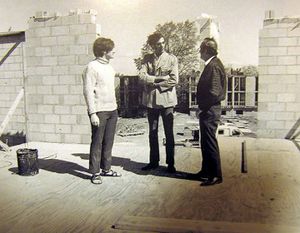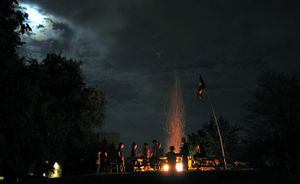Difference between revisions of "History"
Prairiedogz (talk | contribs) |
|||
| Line 27: | Line 27: | ||
Today the two basement kitchens are still referred to as Renaissance and O'Keeffe, and the nine sections of the building that were once separate houses are now "suites" bearing the same names. | Today the two basement kitchens are still referred to as Renaissance and O'Keeffe, and the nine sections of the building that were once separate houses are now "suites" bearing the same names. | ||
| + | |||
| + | === Notable Events === | ||
| + | [[Plumbageddon]]<br> | ||
| + | [[COVID-19]]<br> | ||
| + | [[Northeast blackout of 2003]] | ||
Revision as of 08:00, 28 November 2020
Escher House has a rich history of being a pretty sweet house.
The ICC page has more information on the history of the ICC.
HUD loan
During the 1950s, the University of Michigan responded to post-war growth by developing North Campus, ensuring future demand for nearby student housing.[1] The ICC persuaded the University to set aside three acres of a hilltop off Broadway for a "cooperative village." When the government made low-interest loans available in 1958, the ICC began planning in earnest. Due to University hesitation to co-sign, however, the project was delayed until Congress removed the co-signature requirement in 1964.[2] The ICC finally procured a $1.24 million, 50-year low-interest loan from [[wikipedia:United_States_Department_of_Housing_and_Urban_Development|HUD] for its North Campus project in 1968. This was the first-ever HUD loan to a non-profit student-owned housing program, marking a high point of student organizing at the campus which had already helped birth the 1960s student movement through the Students for a Democratic Society. According to Luther Buchele, the shaggy ICC delegation that traveled to Chicago to accept the loan underscored this unprecedented level of student activity:[2]
One middle aged woman in the HUD office noted the long hair on John Atchaz, John Gourlay, Rex Chisholm, and Smokey Geyer. She said haughtily to me "This must be a delegation of visitors." "Would you like to loan a group like this a million dollars?" I asked. She answered, "I certainly would not!" I then informed her that HUD had indeed made such a loan and she looked sour.
Tampold & Wells, an architectural firm which had designed co-ops at several Canadian universities, laid out a complex consisting of eighteen interconnected "houses" arranged around the crest of the hill the ICC had reserved.
Although a fall 1970 opening had been scheduled, the building was not ready in time for the start of classes.[3] Prospective residents slept on the floor at the adjacent fraternity house (now the Stearns Building) until the building was finished.
Nine houses
Despite the initial plans, it does not appear that the North Campus building ever functioned as eighteen separate co-ops. Instead, the planned eighteen were consolidated into nine “houses” making up the “North Campus Division” of the ICC. Each house had 24 members and its own treasurer, although co-op meals were shared in the two basement dining halls. The names of the houses reflected the social, political, and literary interests of members at the time: Sinclair was named for then-imprisoned Ann Arbor poet and activist John Sinclair, Russell for pacifist philosopher Bertrand Russell, Zapata for Mexican revolutionary Emiliano Zapata, and Bag End for the home of Bilbo Baggins in Tolkien's Shire. With 9 houses, members possessed both a housing contract and a boarding contract in one of the kitchens - O'Keeffe was the Northwest Boarding Coop, Renaissance was the Southeast Boarding Coop. Southeast Boarding Coop meals were vegetarian whereas Northwest Boarding Coop meals were not.
Residents joked about the "Tofu Curtain" dividing the building just as the Iron Curtain had divided Europe.[4]
Three houses
By the early 1980s, the North Campus co-op system showed signs of strain. To address rising vacancies and turnover, the board voted in 1984 to make the building's large rooms optional singles, instead of assuming that each would have two students. Despite this policy, occupancy remained lower than desired. Consultant Jim Jones, who had worked with other large houses at the Inter-Cooperative Council of Austin, attributed the problems to the limited time of the co-op population, which consisted almost entirely of graduate students. Jones also considered the administration of nine separate houses to be inefficient.
With the ICC Board, Jones oversaw the 1985 rebirth of North Campus as two houses: Renaissance and O'Keeffe. Each was organized around one of the two basement kitchens, similarly to the Austin College Houses model. Consolidating the nine co-ops into two may have saved the North Campus project from the unfortunate fate that befell other large student co-ops like Berkeley's Barrington Hall), although cultural factors may have also played a significant role.
The Board considered consolidating the building into a single co-op, but decided against it. Jones, noting that the North Campus building and old "North Campus Division" had been artificially "defined out of existence" as a cohesive whole, in 1987 proposed a new "third body" to represent the shared interests of all North Campus co-op residents on the board of the ICC. This entity became Escher House.
One house
Over the 1990s, and into the 2000s, Renaissance and O'Keeffe had distinct cultures. For a time, a point of contention was that the larger O'Keefe house could afford both vegetarian and omnivore meals options, whereas Renaissance had no vegetarian options. The increasingly expensive Ann Arbor rental market prompted a gradual increase in the number of undergraduate students at the Renaissance and O'Keeffe. The old problem of inefficient administration reared its head once more, as two separate teams of officers coped with peak occupancy.
In April 2014, Renaissance and O'Keeffe merged into Escher House via ratification of a new constitution. This document implemented changes based on lessons learned from a number of co-ops over many years. A single officer team replaced the previous two, a House Council was created for officer oversight, and a Judiciary Committee was introduced for hearing specific member appeals. Thanks to a policy exception granted by the ICC, Escher was granted three board members, ensuring North Campus residents' representation on the board was unchanged.
Today the two basement kitchens are still referred to as Renaissance and O'Keeffe, and the nine sections of the building that were once separate houses are now "suites" bearing the same names.

